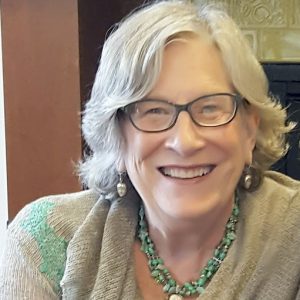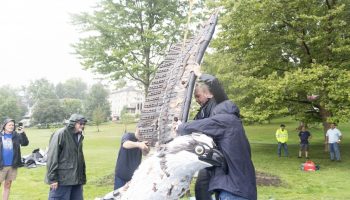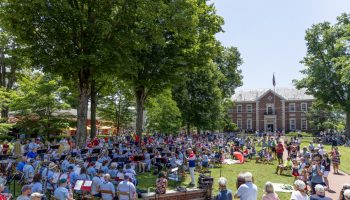
Blaze. Cupcake. DragonSlayer. Luv Bug. Mamacita. Prima. Sugah. The Rev.
They are eight of 23 “TMR Moms,” and one Dad, across the globe who parent children with autism spectrum disorder and chronic childhood diseases and disabilities. Called “The Thinking Mom’s Revolution,” they share a blog full of stories “of healing, truth, justice and hope” each day. TMR includes grandparents, as well as other parents.
“These are tiger moms who don’t listen to the doom and gloom of professionals,” said Patricia Lemer, an educational diagnostician for more than 40 years, licensed professional counselor, author, podcast co-host and speaker. “And grandparents have a lot of clout and wisdom; they’re very involved.”
Lemer will conclude this season’s Chautauqua Speaks program with a talk titled “Autism Spectrum Disorder: Whats New?” at 9:15 a.m. Thursday, August 22 at the Chautauqua Women’s Club.
“I’m going to talk about red flags and how they lead to autism,” she said.
Her new book, Outsmarting Autism, Updated and Expanded: Build Healthy Foundations for Communication, Socialization, and Behavior at All Ages, was published in March. She said that she downloaded her brain into it.
“The old-fashioned thinking is that (ASD) is a lifelong disorder and mystery that we’re unable to deal with,” Lemer said. “The new thinking is that we know some of the risk factors, we can recognize it early, cut it off at the pass, get to the root of the problems, and heal them. Ten years ago, the word ‘heal’ was whispered; now we’re shouting it. … We can figure out what’s going on and get these kids up and functioning.”
And that’s not all, she said: “If we know what risk factors are involved, we can actually prevent it. Two of my friends have written books about how to stop it.”
Originally from Pittsburgh, Lemer left at age 15, and did not return for 40 years. She said that she spent most of her career in the Washington, D.C. area.
“I was a nerdy student who liked math and quantifying human behavior,” she said.
Double-majoring in psychology and math at Simmons College in Boston, Lemer graduated a semester early and entered Boston College, where she earned a Master of Education in counseling and learning disabilities.
Hired as a junior psychologist by a Boston hospital, she began to wonder if she was just treating the symptoms of children demonstrating aberrant behaviors, while the members of the multidisciplinary team of doctors, occupational therapists and speech language pathologists with whom she worked were treating the underlying causes, such as diet and movement.
Lemer said that in the late 1960s, when she was starting out, the kids she saw had severe physical and cognitive issues, including cerebral palsy, Down syndrome (trisomy 21), and what at the time was called “mental retardation” (now intellectual disability, general learning disability).
She soon moved to the Washington, D.C., area and joined a team of educators. Again she seemed to be treating symptoms — such as reversal of letters of the alphabet and slow, dysfluent reading.
During the early 1970s, she took part in drafting Public Law 94-142, the Education for All Handicapped Children Act, which President Gerald Ford signed into law in late 1975. It significantly amended Part B of the 1966 Education of the Handicapped Act.
EAHCA mandated, in part, that all public schools accepting federal funding provide equal access to education to children with physical and mental disabilities. The schools were required to evaluate these children, and with parental input, to develop individual educational plans that would come as close as possible to emulating the experience of students without disabilities.
“I was working with attorneys on this legislation and was responsible for drawing up the requirements for the schools,” Lemer said. “I was a part of writing it and determining what services children should get if they had a handicapped condition.”
According to Lemer, 12 conditions were listed, including deafness, blindness, cognitive impairment, and physically and learning disabled.
“They were hard fought for,” she said. “So in the ’70s I advocated (for services) and went to a lot of schools. Parents (had) thought they would have to pay for a private school. … For the first time, schools got involved.”
As an educational diagnostician, Lemer tested children to determine if they were learning disabled and needed services. She began working with a multidisciplinary group of professionals, including occupational therapists, physical therapists and speech language pathologists.
“There were kids with dyslexia who couldn’t read, and kids who couldn’t put their thoughts on paper,” she said. “Because I don’t like labeling, I kept asking ‘Why?’ Why is this kid losing his place on the page?”
In 1979, Lemer encountered the field of optometry, which unlike ophthalmology is not a branch of medicine specializing in diseases and surgery of the visual pathways, but is instead a health care profession dealing with the eyes and their structures, vision (rather than eyesight), the visual system within the brain and vision information processing.
Further encounters over the years changed Lemer’s professional life, and led to her editing a book, EnVISIONing A Bright Future: Interventions that Work for Children and Adults with Autism Spectrum Disorders, which was published in 2008 by the Optometric Extension Program Foundation.
During the 1980s, Lemer worked as a career counselor at George Washington University, and as a psychometrist at GW’s counseling center. She also helped families in the District of Columbia, Maryland and Northern Virginia, to get schools to comply with EAHCA.
For families with children who needed help, she said she would go to due process hearings to help them get services.
“But more importantly, with the families I would look at what was causing (the disability),” Lemer said. “That’s really what I’m known for — getting to the causes, the biology. … I wanted to alleviate the symptoms so the child wasn’t wearing the red badge of ‘disabled.’ ”
For instance, she wanted to know what the children ate for breakfast, if they had any food allergies and what their sleep habits were. Lemer said she worked with nutritionists, occupational therapists, optometrists and other professionals in health-related fields.
“I did psychological testing for most of my career, and I called myself a ‘diagnostician,’ ” she said.
According to Lemer, by the 1980s, being learning disabled was the “old problem,” and Attention Deficit Hyperactivity Disorder was the “new problem.” She said that she was deeply involved in ADHD conversations and that there was a movement to get ADHD listed as one of these disabilities, but because no one could pinpoint what it was, it failed.
“By the end of the 1980s, I was starting to see qualitatively different kids,” Lemer said. “By the early ’90s, it was clear that something had happened. That’s when autism started raising its ugly head.”
According to Lemer, one late Friday afternoon in 1993, she listened to the answers that a mother was giving to Lemer’s questions about her son. For example: “Does he drink a lot of milk? Has he had ear infections?” She was tired, and told this parent that she’d heard the same story over and over again.
“I had an epiphany,” Lemer said. “This mother was a lawyer. She said, ‘I’m home with my kids. If there are lots of kids like mine, then we need to start an organization.’ ”
In April 1994 — before the internet and email existed to connect families — Lemer co-founded Developmental Delay Registry, with this concerned parent and two other professional women working with children with special needs, and began serving as its executive director. Developmental Delay’s tagline was: “Integrating conventional and holistic approaches to learning and behavioral problems.”
Four years later, “Registry” was changed to “Resources” to better reflect DDR’s primary mission — disseminating information and networking about developmental delays.
Lemer said that since people were coming to the Washington, D.C., area to use the U.S. National Library of Medicine, DDR started there. Several years later, when she returned to Pittsburgh, DDR moved with her.
In the meantime, however, Lemer enrolled at Johns Hopkins University to learn how to run a nonprofit organization, and graduated in 1999 with a Master of Science in Business.
From 2012 to 2014, she served as the chief consultant for the establishment in Kuwait of Center 21, which provides therapeutic and recreational services for young adults with disabilities. Its motto is: “Putting the able in disabled.”
In 2013, Lemer merged DDR with Epidemic Answers, a nonprofit based in Windsor, Connecticut, that provides educational resources and networking tools to parents who are trying to understand why their children are chronically ill.
The following year, Outsmarting Autism: The Ultimate Guide to Management, Healing, and Prevention — a 550-page book that Lemer had been writing — was completed and published.
The “verdict” of the prestigious Library Journal regarding Outsmarting Autism, Updated and Expanded was that “this all-in-one guide should be on every pediatrician’s, teacher’s, and service provider’s radar, and on the shelf of essential resources for parents of children with autism.”
Currently, Lemer teaches courses about lifelong autism and staying healthy in a toxic world at the Osher Lifelong Learning Institute at Carnegie Mellon University and the University of Pittsburgh.
As the “Diagnostic Diva,” she and the “Curious Chemist” (Kristi Wees) began co-hosting a weekly podcast in early 2019, called “I Have a Child Who …” — for instance, “I Have a Child Who Has Autism.”
And on Tuesday mornings this summer, Lemer and Andy McCabe, a professor in the special education department at New Jersey City University, began broadcasting “The Autism Detectives” live on HealthyLife.net Radio. It can also be heard on-demand and as a podcast.
At Chautauqua during Week Three, Lemer taught a Special Studies course on one of her hobbies — beading jewelry. She creates unique beaded jewelry, knitted apparel and quilts for relaxation.




